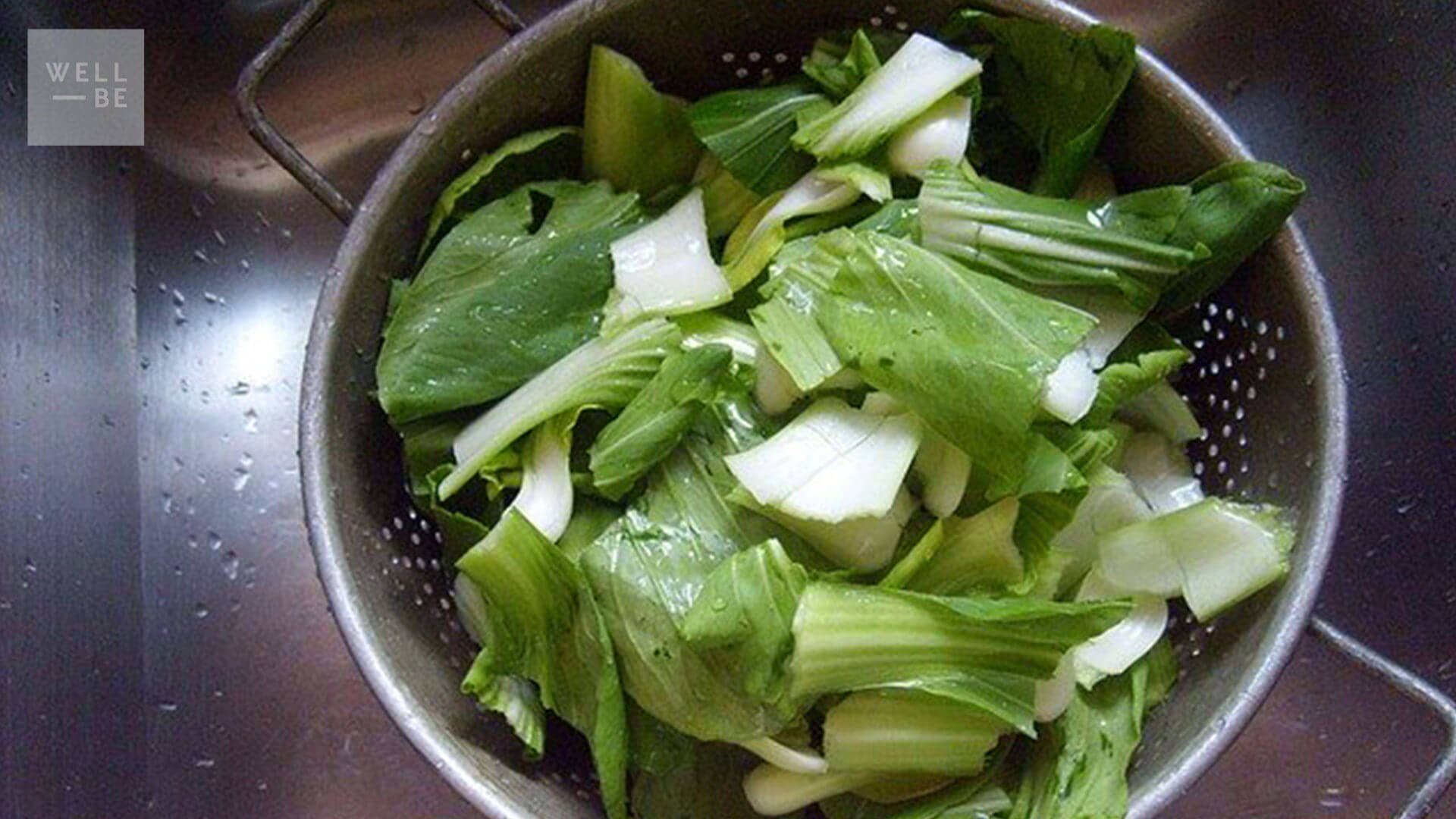Be honest: when you want to eat some fruit or a vegetable, do you give it a thorough wash or do you just rinse it under running water for a second? If you’re doing the latter, we’re not judging — you’re probably in the majority — but there are some pretty compelling reasons that you should up your produce-washing game, including investing in a good veggie wash (yes, that’s a thing!) and why rinsing isn’t necessarily the best method. Read on to learn both why and how to wash produce correctly, our favorite fruit and vegetable wash options, and more.
Why Do You Need to Wash Produce?
If you’ll remember, during the height of the Covid-19 pandemic, people were washing their produce (and all their other groceries) pretty obsessively — which makes sense, since soap and water is the most effective way to kill a virus. But when there’s not a pandemic, there are two primary reasons to wash produce: to get rid of pesticide residue and to reduce risk of bacterial contamination.
Nearly 75% of produce sold in the United States has pesticide residue, according to the Environmental Working Group. The USDA reports that some of the biggest culprits (meaning they have pesticide levels exceeding EPA tolerances) include common fruits and veggies like asparagus, cucumbers, kale, onions, and sweet potatoes. You can also always refer to the EWG for their annual Dirty Dozen report, which provides an updated list of which produce has the most pesticide residue.
This all matters a great deal, because pesticides are linked to tons of human health problems, including short-term issues like diarrhea or cold-like symptoms, as well as more serious or chronic conditions, such as cancer, infertility, and neurological damage. To avoid pesticides, it’s best to always buy organic when possible.
But even if you do go organic, it’s still essential to wash your produce. Why? First of all, because according to USDA regulations, organic farmers can still use certain pesticides as a “last resort.” What’s more, even buying pesticide-free organic produce doesn’t protect you from the second risk of unwashed produce: microbial (bacterial, viral, fungal, parasitic contamination).
Many people associate foodborne illness with meat, fish, and poultry, and don’t think of fruits and vegetables as major potential sources of harmful microbes. This couldn’t be further from the truth.
In recent years, raw produce has been linked to a multitude of foodborne illnesses due to bacterial contamination. Remember the great romaine debacle of 2018? Or the parasites spread through raw, pre-cut veggies? And more recently, there was a massive recall of frozen fruit available at Costco and Trader Joe’s due to a potential hepatitis A contamination! This latter one is particularly notable, because plenty of people assume that if something is frozen, it’s safe (spoiler: it’s not). A big new recent report about food borne illness outbreaks from restaurants points to sick food handlers. This is true for buying groceries, getting takeout, getting prepared foods in the market or getting delivery as well. You don’t know who has touched your food and what they touched just before they touched your food so why not be safe and wash your raw food yourself?
There are many different ways that produce can become contaminated in its journey from plant to your plate. For instance:
- While it’s growing, it can come in contact with animals or their feces on the ground.
- When it’s transported to the store or farm stand, it can be improperly handled or stored, or come in contact with a contaminated surface or being.
- Once it’s at the store, it’s picked up by grocery store workers and countless shoppers trying to decide whether they want to buy that particular piece of produce. All of these encounters introduce some risk of contamination.
What’s more, we now live in a globalized and industrialized food system. Before the globalization of food, it used to be that food came from farms in your area, just a few miles from where you lived, and was brought into the village or town for you to buy. Compared to today, this required far fewer people to touch that produce between the time it was picked by the farmer and when you bought it a few days later nearby. It also spent less time in storage, reducing the amount of time dangerous bacteria, fungus, viruses, and parasites could grow on it.
Another reason this was healthier for you is because local food was grown in your local dirt, meaning the microbes in your gut recognized the microbes in that dirt, and did not see them as harmful invaders. This was actually good for your gut heath, as it grew the good bacteria in your gut. Now, produce comes from far away, where different environments lead to different microbiomes in the local population — meaning bacteria on an apple that might be perfectly harmless to someone in, say, Chile (because their microbiome is used to that bacteria) might cause severe gastrointestinal problems for someone in New York, whose microbiome has never encountered that particular bacteria before.
Today, most of our food travels across the globe, is touched by many different people with different microbes and levels of hygiene, and is stored for months before it ends up in your supermarket. In short, there are a ton of potential ways for that cucumber you’re holding to have become contaminated with bad bacteria, parasites, viruses, fungus, and all sorts of microbes.
This is concerning, because foodborne bacteria like Salmonella, E. coli, and Listeria can cause some very unpleasant symptoms, such as headache, muscle aches, fever, cramps, and even convulsions. Plus, these bacteria often require antibiotics to get rid of, which we want to avoid at all costs because of the havoc they can wreak on your gut health. And even if you don’t get a full-blown foodborne illness, you want to keep the ratio of bad to good microbes in your gut down to support overall health in areas like digestion, mental health, immunity, and more. If all it takes to avoid this unpleasantness is washing your fruits and vegetables before you eat them, then there’s no reason not to do it!
But, strange as it may sound, most of us don’t actually know how to wash produce properly. Don’t worry, we’ll cover that next.
How to Wash Produce Properly
First off, you should know that even if you’re not planning on eating the skin of a piece of produce, you should still wash it. This is because it’s very easy for contamination on the exterior to make its way onto the interior when you cut or peel the produce. Think about it: if you use your hands to peel a bacteria-laden orange and then you handle the inside pieces, the bacteria will transfer to the inside pieces from your hands. Sorry, no shortcuts here!
When it comes to how to wash produce, the first step is actually to wash yourself! After all, you don’t want to go through all the trouble of decontaminating your produce only to transfer bacteria from your hands onto the items. The FDA recommends washing your hands with soap and warm water for at least 20 seconds both before and after you wash your produce.
At WellBe, we’re big fans of using natural fruit and vegetable wash to decontaminate our produce. We’ll go into our favorite fruit and veggie wash brands below, but first let’s cover the process of how to wash produce correctly. Luckily, the process is super simple:
If you’re using veggie wash that comes as a liquid concentrate:
- Place your items in a large bowl of cold water and add a couple drops of your veggie wash until it appears sudsy
- Let it sit for about 15 minutes (if you tend to buy a lot of produce at once, you’ll probably need a few bowls. We like metal mixing bowls like these).
- Then, simply take the produce out, dry it off, and enjoy! There’s no need to rinse or do any further washing — the fruit and vegetable wash does all the work. And remember, pouring the dirty water back over the now clean produce isn’t a good idea either! Simply take the produce out and put into a salad spinner or colander to dry.
If you’re using veggie wash that comes in a spray bottle:
- Spray the piece of produce
- Scrub for 20-30 seconds
- Rinse
If you want to know how to wash produce without a veggie wash, the FDA provides clear, simple instructions. They recommend washing your produce under cold, running water, scrubbing with your hands or a clean produce brush, and then drying thoroughly with a clean paper towel or dish towel. With both methods, the drying part is just as important as the washing part, as it can remove any lingering bacteria on the skin.
And one last tip! While it might seem more efficient to wash your produce as soon as you get home from the store or farmer’s market, it’s best to wash them right before you’re about to use or eat them. That’s because dampness encourages microbial growth and thus makes produce spoil faster.
The Best Fruit and Veggie Wash Brands
There are a lot of fruit and vegetable wash products on the market, so choosing the right one can be confusing. We’re here to help you by breaking down the different types of veggie wash and how to decide which is best for you.
The first thing to know is that veggie wash comes in two different forms, which we referenced above: in a spray bottle or as a liquid concentrate. As you probably noticed, washing produce with a spray bottle is a quicker process, but it isn’t very convenient for multiple pieces of produce (or produce that can’t be scrubbed easily, like berries or leafy greens). Additionally, spray versions of veggie wash are less concentrated, so you’ll go through the bottles more quickly. These are important factors to consider when deciding which type to get.
In terms of ingredients, most natural fruit and veggie wash contains one or a combination of the following ingredients:
- Citrus oils: Extracts from citrus fruits like lemon or grapefruit, which cut through residue and break apart bacteria. Grapefruit seed extract is a natural microbial, containing potent compounds that can kill more than 60 types of bacteria.
- Sunflower or coconut oil: Plant oils are often used in commercial fruit and vegetable wash as a way to dilute more potent ingredients and help deliver the active compounds to the produce.
- Ethyl alcohol: As we discussed in our guide to natural virus killers, substances that have an alcohol content of 60% or more can kill viruses. They can also kill bacteria and other dangerous microbes that might be lingering on the surface of your produce. Of course, it will need to be food-grade, plant-based ethyl alcohol in order for it to be safe to use on your food.
But our favorite veggie wash is not a spray, it’s a concentrate like this one by Nutribiotic or this one from Nuturity, which uses grapefruit seed extract (also known as citricidal). We like that it’s totally natural and plant-based, and that it delivers the other benefits of grapefruit seed extract, such as antioxidants and a protective effect against UTIs, heart disease, and other conditions.
Some other popular but not-as-great veggie wash brands include:
- Veggie Wash: This is a popular spray vegetable wash that uses citrus oil to disinfect. Unlike our preferred vegetable wash above, the non-organic version also contains a bunch of other ingredients, like potassium sorbate and decyl glucoside. Note that we linked to the organic version for that reason and would not recommend the non-organic version.
- Environné: This is another liquid concentrate that relies on citrus oil to kill bacteria. It’s also Kosher Certified, though the full ingredient list is not available on their website.
- Fit Organic: This USDA Organic and Kosher spray combines the power of ethyl alcohol and citrus oil to kill any dangerous microbes, and uses organic sunflower oil as a diluting base.
While we recommend the Naturity or Nutribiotic grapefruit seed extract products most, any of the above veggie wash brands will help you ensure that your produce is free of pesticides, bacteria, viruses, and anything else you might not want to eat. For a full list of WellBe vetted and approved fruit and vegetable wash brands, plus thousands of other products across 20+ categories, check out the WellBe Non-Toxic Product Database.
DIY Fruit and Vegetable Wash
If you don’t want to spend the money on a commercial veggie wash, you might be wondering how to wash produce with just the items you already have at home. Good news — you have options!
Here are three simple, DIY versions of veggie wash that you can make in your kitchen in a matter of minutes:
- Vinegar-based fruit and vegetable wash: White vinegar is a powerful disinfectant. Just combine vinegar and cool water at a 1:9 ratio, and let your produce soak the way you would with a commercial fruit and vegetable wash.
- Baking soda-based fruit and vegetable wash: Research shows that baking soda is very effective at removing pesticides from the surface of produce. Just make a solution by mixing together 2 teaspoons of baking soda per 1 quart of water, and submerging your fruits and vegetables in it, then rinsing and drying.
- Lemon juice-based fruit and vegetable wash: As we mentioned, citrus oils can help disinfect produce. And while you may not have grapefruit seed extract lying around, you can approximate its effect with lemon juice plus white vinegar. Just add two tablespoons of lemon juice to ¼ cup of white vinegar and two cups of water.
With each of the DIY vegetable wash methods above, the same guidelines apply in terms of how to wash produce: make sure you start with clean hands, use cool water, and fully dry the produce afterward.
The WellBe Takeaway on Washing Your Produce
Washing your fruits and vegetables can seem like an unnecessary chore, and many people skip it or just do a cursory splash of water and call it done. But it’s actually an essential step to help avoid harmful chemicals and microbial infections, and it’s important to do it correctly.
Here’s what to remember about how to wash vegetables and fruit:
- There are two reasons to wash fruits and vegetables. First, to remove any pesticide residue, and second, to remove any potential microbial contamination.
- Even organic produce needs to be thoroughly cleaned before eating it. This is because certified organic farmers are allowed to use certain pesticides as a last resort, and because organic produce isn’t spared from microbiall contamination.
- The FDA guidelines for how to wash vegetables and fruit are to: begin with clean hands; run your produce under cool water; scrub your produce with a clean brush or your hands; thoroughly dry with a clean paper towel or dish towel. Of course this method is difficult with most produce, unless it’s big and firm like an apple or orange.
- At WellBe, we prefer to use a liquid concentrate as a fruit and vegetable wash and soak our produce for 15 minutes. You can choose a spray version for your vegetable wash instead, but we prefer the concentrate version and the best versions will always use grapefruit seed extract and contain only organic ingredients.
- Remember to wash your produce just before you think you’ll consume it, because dampness encourages bacterial growth and thus makes produce spoil faster.
- If you can’t find a commercial fruit and vegetable wash, you can make one using ingredients you have at home. White vinegar, baking soda, and lemon juice can all be used to make a DIY fruit and vegetable wash.
Do you have a favorite fruit and veggie wash? Tell us in the comments below!









How do you store washed vegetables?
Hi Annette, that is a great question! We recommend sticking to metal or glass storage containers. At the end of this article, there is a link to an Eco-friendly Stainless Steel Mixing Bowl Set, that comes with tops, which works great for storage. Also if you haven’t already, be sure to sign up for weekly newsletter here. Xx Adrienne & Team WellBe